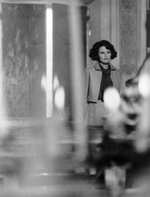
Silvana Mangano in
Pasolini Teorema,
1968
KByte
I borrowed this title from Pasolini, snatching it from his tiny short film, where Totó and Ninetto, the duet of Father and Son from the tales can at last be completed with the much desired (feared) mysterious figure of the Mother-Wife. All this, however, is seen this way form the Moon alone, e.g. from a suitably distant perspective, still close enough to allow us to nod – well, how beautiful it indeed is!
The same distant as well as close perspective was chosen by the Italian film scientist Francesco Casetti for the purposes of an overview in his work entitled Theories of Film, becoming available in a Hungarian student edition by this autumn, directed also at researchers and the interested public, as a tribute from the Osiris Publishing House, summarising every thought that has emerged since 1945 in the heads of that incorrigible troupe of film thinkers who feel an irresistible drive to measure and explain, dismount and assemble the moving picture, just like children do with toys in order to see what is inside.
Casetti's perspective is distant enough to look upon this earthly landscape impartially, to see the intertwined ranks of peaks, valleys and craters, devoting equal interest to the approach which simply wishes to answer Bazin's question "What is film?" and which he therefore considers ontological, to those methodists who want to squeeze their subject into the framework of an external scientific discipline, among them to the giant of semiotics engulfing everything, to the schools starting with the belligerent imperative of "What should a film be like?", or to those philosophers from Adorno to Deleuze who regard film as a suitable part of a method analysing reality. At the same time, he is close enough to watch the unfolding lines of thought, harmonies and differences, the sometimes stronger, sometimes weaker footprints of social and spiritual history of the half century examined. Since film, it seems, holds a shamelessly closer, more intimate relationship with reality than do other fields of art, responding quickly and unveiled to every tiny bit of change.
Consequently, the book can be used in several different ways just like film itself, responding according to the question raised. It can both be a textbook and a manual. In a clearly arranged, concise structure it leads the interested reader through the bushes of complicated post-war theories, informing not only of the most picturesque tendencies but also of the detailed work done in the background, the disputes conducted on the magazine pages, and doing that always strictly along the lines of questions arising and to be answered, thereby avoiding the trap of evaluation. Casetti offers a rich selection, and his major advantage is that he refuses to make up our minds instead of us, laying out the different theories while staying strictly in the scope of thoughts of the author presented.
From this aspect, the last few chapters are the most interesting. Surveying the developments of the most recent times, one can observe how a need for a concise approach again is born, by the resurrection of the ontological way of thinking supported by the highlighting of an element held to be essential on one hand, and by the method that sees film as part of the fabric of social, economic, technological, linguistic and aesthetic processes, refusing to consider either of its sides as absolute yet making use of all the results that fifty years' of specific research brought to the surface. This is when the reader cannot fail to appreciate the approach that mixes historical and problem-oriented thinking and that shapes the logic of this book from the very beginning. Theory of film, although going through very definite changes from time to time after the war, has not developed along a liner course, taking the route of gaining inner wealth and approaching its topic from ever new directions.
And this is the point where one identifies another reading of Casetti's book. Let us for a moment push everything into the background that Casetti tells us of film - our mutual love - with such impressive learnedness and scientific professionalism and listen to what moves in the background, i.e. the movements of the intellect and its changes of colour, the alterations of focus in the questions raised by film in its capacity of a special surrogate of reality, and the current style and tune of disputes. The neorealistic dispute, the attacks of Cahiers against father's cinema, Pasolini and Eco, Feminist Film Theory and the different waves that gain and use popularity: structuralism, deep psychology, politics, in order to mention only a few ill-famed issues. Because for example what one from time to time thinks of the relationship between reality and film does not necessarily solve the secret of film, - at least that has not happened so far - but such attempt will certainly reveal what kind of relationship one has with reality himself. The fact whether one is trying to find a general rule of thumb, whether one desires to see film as a unity, an laudable individual entity or is satisfied with surveying it only through some of its comprehensible features certainly reveals a lot about whether one sees the world as a whole, or only as a group of loosely connected parts, or perhaps as a pool of disconnecting fragments. The world of film as disclosed in Casetti's book moves and changes along with the intellectual world of which it is both an object and a contributor.

